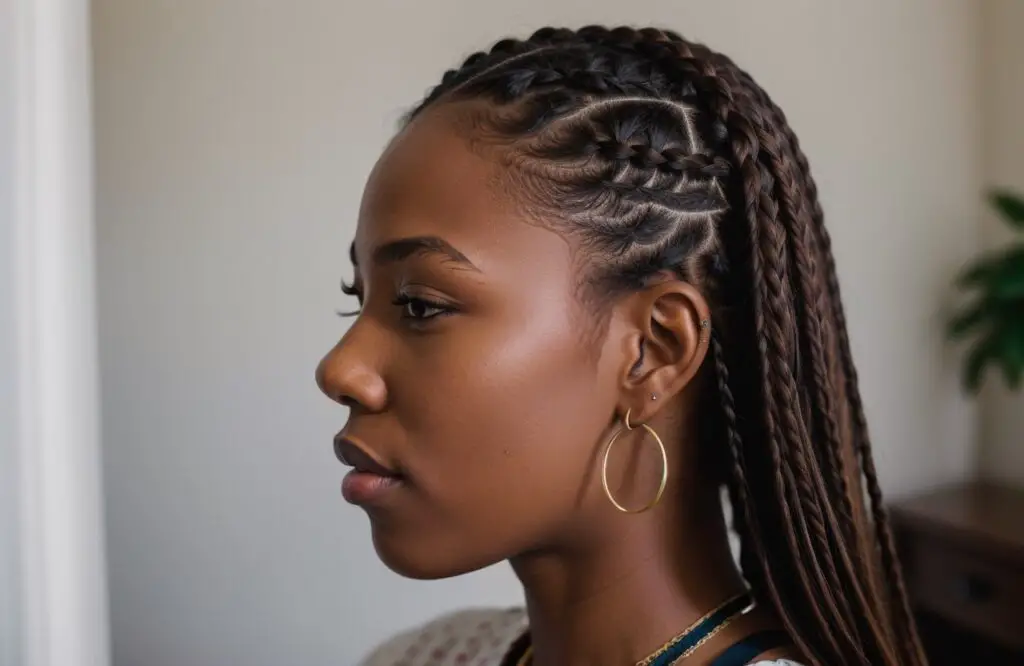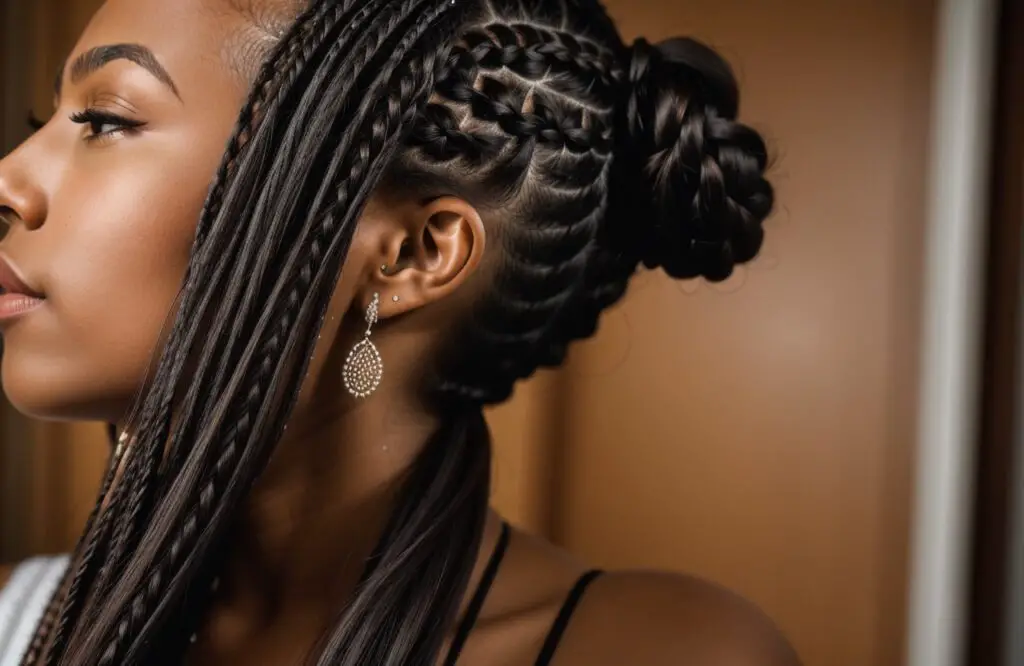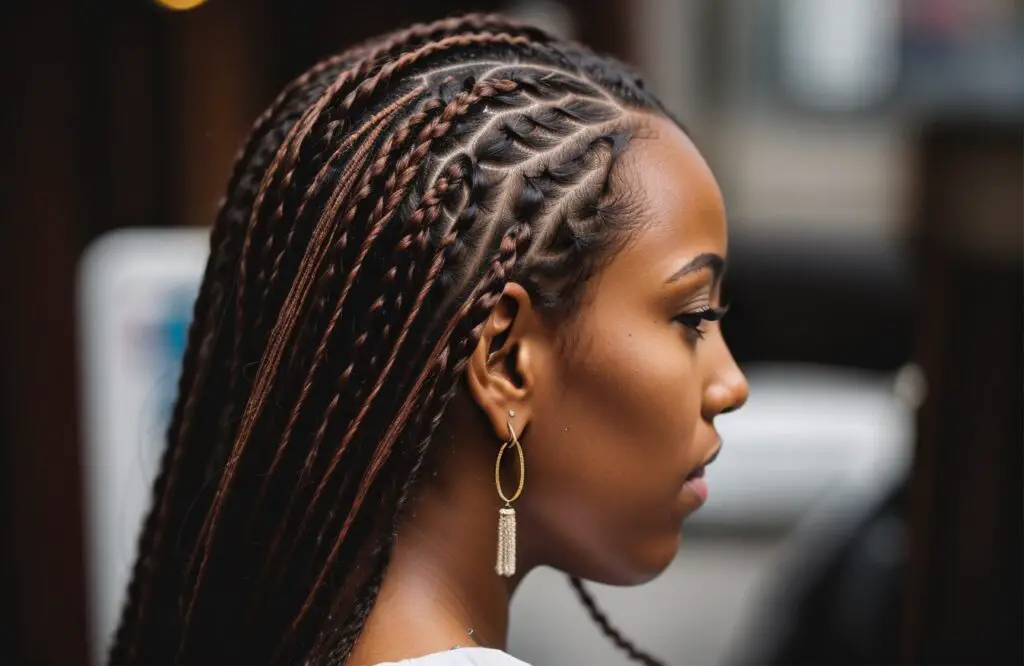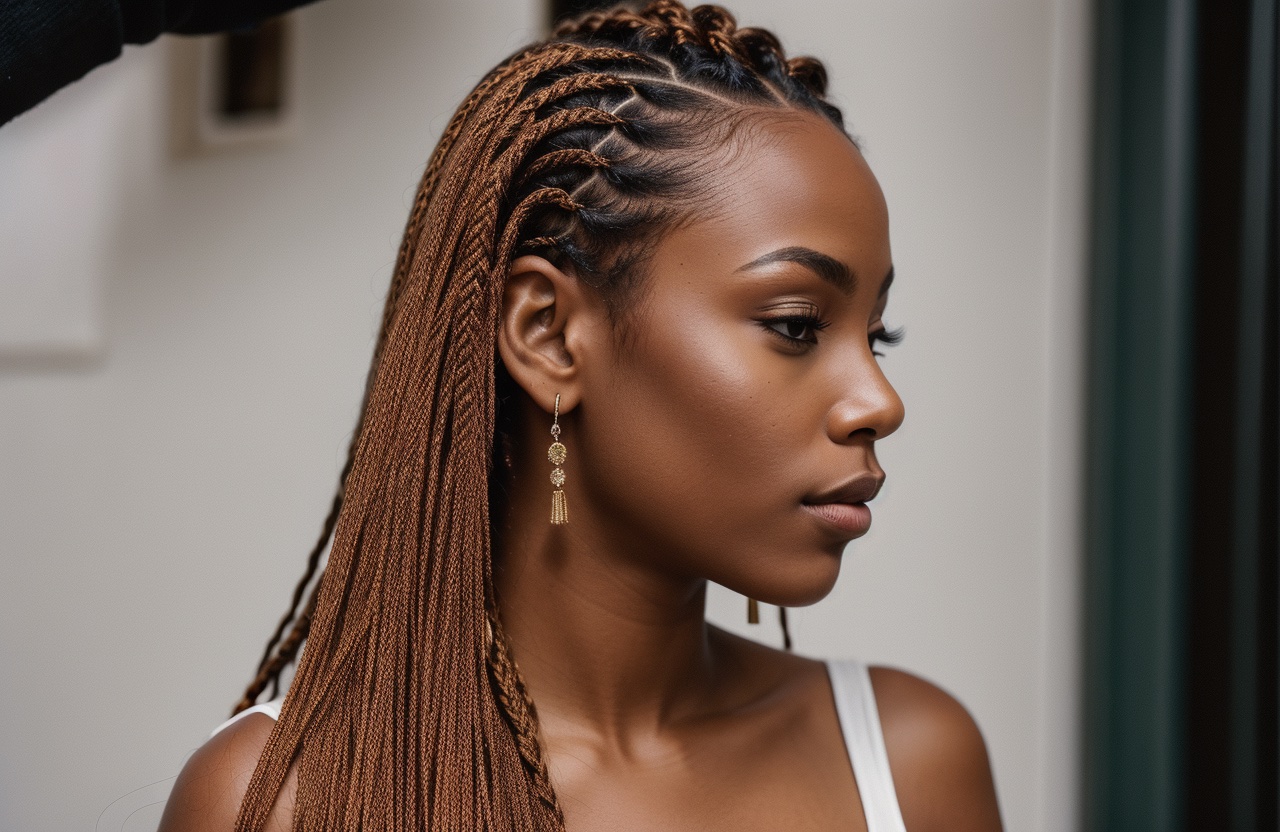Micro braids are tiny, intricate braids that add texture and style to your hair. These fine plaits, often no thicker than a pencil lead, offer a versatile and long-lasting hairstyle option. Women love micro braids for their ability to protect natural hair while providing endless styling possibilities.
The popularity of micro braids stems from their low-maintenance nature and durability. Once installed, these tiny braids can last for weeks, saving time on daily styling routines. They’re also incredibly versatile, allowing for various updos, ponytails, and creative styles. Plus, micro braids work well for different hair types and textures, making them a go-to choice for many women.
In the following sections, we’ll share everything you need to know about mastering the micro braid technique. From the essential tools and preparation steps to the braiding process itself, we’ll cover it all. You’ll also find tips on maintaining your micro braids and creative styling ideas to keep your look fresh. Keep reading to discover how to achieve stunning micro braids from roots to tips.
- What tools do you need for micro braiding?
- How do you prepare hair for micro braids?
- What's the step-by-step process for creating micro braids?
- How long does it take to install micro braids?
- What are the best ways to maintain micro braids?
- How can you style micro braids creatively?
- Unlocking the Versatility of Micro Braids: Your Path to Stunning Styles
- Frequently Asked Questions
What tools do you need for micro braiding?

Creating micro braids requires the right tools to achieve a polished and long-lasting result. Let’s explore the essential items you’ll need to master this intricate hairstyle.
Rat-tail comb
A rat-tail comb is a must-have for micro braiding. Its fine-toothed end helps create precise partings, while the pointed handle is perfect for separating small sections of hair. This tool allows you to work with tiny strands, which is crucial for achieving those ultra-thin braids.
Why is a rat-tail comb so important? It helps you maintain neat, even sections throughout your head. This precision is key to creating a uniform look and preventing tangles as you braid.
Small hair elastics
Tiny, clear elastics are your best friends when it comes to securing micro braids. These small bands hold the ends of your braids in place without adding bulk or being too noticeable. Opt for elastics that match your hair color for a seamless finish.
How many elastics will you need? It’s better to have too many than too few. For a full head of micro braids, you might use hundreds of these little bands, so stock up!
Hair clips
Sectioning clips are essential for keeping your work organized as you braid. They help separate the hair you’re not currently working on, preventing it from getting tangled or mixed up with the section you’re braiding.
Here are some tips for using hair clips effectively:
- Use larger clips to section off big areas of hair
- Employ smaller clips for more precise control of tiny sections
- Choose clips with a strong grip to hold thick or slippery hair
- Opt for smooth-edged clips to prevent snagging
Edge control gel
Edge control gel is a secret weapon for achieving a sleek, polished look with your micro braids. This product helps tame flyaways and baby hairs, giving your hairline a neat appearance. Apply a small amount to your edges using a soft brush or your fingertips for best results.
Moisturizing products
Keeping your hair hydrated is crucial when wearing micro braids. A good leave-in conditioner or moisturizing spray will help prevent dryness and breakage. Look for products that are lightweight and won’t cause build-up, as you’ll be using them regularly to maintain your braids.
How often should you moisturize? It depends on your hair type, but generally, a light misting every other day can help keep your hair and scalp healthy.
Lightweight hair oil
A lightweight oil is the final touch in your micro braiding toolkit. It helps seal in moisture, adds shine, and can help soothe your scalp. Choose an oil that won’t weigh down your braids or make them look greasy.
Some popular options include:
- Argan oil
- Jojoba oil
- Grapeseed oil
- Almond oil
Apply the oil sparingly to your scalp and the length of your braids, focusing on the ends where dryness is most likely to occur.
With these tools at your disposal, you’re well-equipped to create beautiful, long-lasting micro braids. Remember, quality tools can make a big difference in both the process and the final result of your braiding efforts.
How do you prepare hair for micro braids?

Preparing your hair for micro braids is a crucial step that can make or break your final look. The process requires patience and attention to detail, but the results are worth the effort. Let’s explore the essential steps to get your hair ready for this intricate style.
Washing and conditioning
Start with a clean slate. Wash your hair thoroughly using a clarifying shampoo to remove any build-up or residue. This step is vital because it allows the braids to grip your hair better and last longer. After shampooing, apply a deep conditioner to nourish and hydrate your strands.
How long should you leave the conditioner on? Aim for at least 15-20 minutes, or follow the product instructions. For extra hydration, you can even leave it on overnight with a shower cap.
Detangling thoroughly
Once your hair is clean and conditioned, it’s time to detangle. This step is crucial for creating smooth, even braids. Use a wide-tooth comb or a detangling brush, starting from the ends and working your way up to the roots.
Be gentle during this process to avoid breakage. If you encounter stubborn knots, apply a small amount of detangling spray or leave-in conditioner to help ease them out.
Sectioning the hair
Proper sectioning is key to achieving neat, organized micro braids. Divide your hair into manageable sections using hair clips or ties. The size of these sections will depend on how small you want your braids to be.
Here are some tips for effective sectioning:
- Use a rat-tail comb for precise partings
- Create sections that are similar in size for consistency
- Secure each section with a hair tie or clip to keep it separate
- Work in rows from the nape of your neck upwards
Applying leave-in conditioner
Now that your hair is clean, detangled, and sectioned, it’s time to add moisture. Apply a lightweight leave-in conditioner to each section of hair. This step helps to keep your hair hydrated throughout the braiding process and reduces frizz.
Why is this step important? Micro braids can be quite tight, which can lead to dryness and breakage if your hair isn’t properly moisturized. A good leave-in conditioner acts as a protective barrier and keeps your hair healthy while it’s braided.
Blow-drying (if desired)
Some women prefer to blow-dry their hair before braiding, while others opt for a natural air-dry. If you choose to blow-dry, use a heat protectant spray first to shield your hair from damage.
Blow-drying can make the braiding process easier by stretching out your hair and reducing shrinkage. However, it’s not necessary if you prefer to work with your natural texture.
If you do decide to blow-dry, use these techniques:
- Set your dryer to medium heat and high speed
- Use a paddle brush or wide-tooth comb to gently stretch the hair
- Work in sections, starting from the back and moving forward
- Keep the dryer moving to avoid concentrating heat in one spot
Whether you choose to blow-dry or not, the key is to make sure your hair is completely dry before you start braiding. Braiding damp hair can lead to mildew and an unpleasant odor.
By following these preparation steps, you’re setting yourself up for success with your micro braids. Take your time with each stage, and don’t rush the process. The care you put into preparing your hair will pay off in the longevity and appearance of your braids.
What’s the step-by-step process for creating micro braids?

Creating micro braids requires patience, precision, and practice. The process might seem daunting at first, but with the right technique, you can achieve beautiful results. Let’s break down the steps to help you master this intricate hairstyle.
Sectioning the hair
Start by dividing your hair into manageable sections. This step is crucial for maintaining organization throughout the braiding process. Use a rat-tail comb to create clean, straight parts. How big should each section be? Aim for sections about 1 inch wide. This size allows for easy handling while still creating small, delicate braids.
Work methodically, starting from the back of your head and moving forward. Secure each section with a small hair tie or clip to keep it separate from the rest of your hair. This organization will help you maintain a neat and uniform look as you progress.
Separating small strands
Now that your hair is sectioned, it’s time to focus on the individual braids. Take a small strand of hair from one of your sections. The size of this strand will determine the thickness of your micro braid. For ultra-fine braids, your strand should be no thicker than a pencil lead.
How do you maintain consistency in strand size? Here’s a tip: use the end of your rat-tail comb as a guide. The thin handle can help you measure and separate strands of equal size, resulting in uniform braids.
Beginning the braid at the scalp
This is where the real artistry begins. Start the braid as close to your scalp as possible. Divide your small strand into three even smaller sections. Cross the right section over the middle, then the left over the new middle. Continue this pattern, incorporating hair from the scalp as you go.
Why start at the scalp? This technique creates a neat, polished look and helps your braids last longer. It also prevents slippage and keeps your style looking fresh for weeks.
Maintaining consistent tension
Consistent tension is key to creating neat, long-lasting micro braids. As you braid, keep a firm but gentle grip on the hair. Too much tension can cause discomfort and potential damage, while too little can result in loose, messy braids.
How do you find the right balance? Pay attention to how your scalp feels as you braid. You should feel a slight tug, but no pain. If you’re experiencing discomfort, ease up on the tension. Remember, practice makes perfect. You’ll develop a feel for the right tension as you go.
Securing the ends
As you reach the end of each braid, you’ll need to secure it to prevent unraveling. There are a few methods you can use:
- Small clear elastics
- Dipping the ends in hot water
- Using a small amount of hair gel or beeswax
The method you choose depends on your preference and hair type. Elastics are quick and easy but may be visible. Hot water sealing works well for synthetic hair extensions. Gel or beeswax can work for natural hair but may cause build-up over time.
Whichever method you choose, be gentle with the ends of your hair. This area is prone to breakage, so handle it with care.
Creating micro braids is a time-consuming process, but the results can be stunning. As you work, take breaks to rest your hands and arms. It’s not uncommon for the entire process to take several hours or even a full day, depending on your hair length and the size of your braids.
Remember, the key to beautiful micro braids lies in the details. Take your time with each step, maintaining neat partings and consistent braid size throughout. With practice, you’ll develop speed and skill, creating intricate styles that turn heads and last for weeks.
How long does it take to install micro braids?

The time required to install micro braids can vary significantly from person to person. This intricate hairstyle demands patience and precision, but the end result is often worth the investment. Let’s explore the various aspects that influence the duration of this process.
Factors affecting installation time
Several elements play a role in determining how long it will take to complete your micro braids. Your hair texture, density, and length are primary factors. Coarser hair might require more time to braid smoothly, while finer hair could be quicker to work with. The desired size of your braids also impacts the timeline – smaller braids naturally take longer to create than larger ones.
Your skill level is another crucial factor. Are you a seasoned braider or a novice? Experienced hands can work more quickly and efficiently, while beginners might need extra time to perfect each braid. Don’t be discouraged if you’re new to this – practice will improve your speed over time.
Average duration for different hair lengths
How long should you set aside for your micro braiding session? Here’s a rough estimate based on hair length:
- Short hair (above shoulders): 4-6 hours
- Medium hair (shoulder to mid-back): 6-8 hours
- Long hair (below mid-back): 8-12 hours or more
Keep in mind these are general guidelines. Your actual time might differ based on the factors mentioned earlier. It’s always better to allocate more time than you think you’ll need, rather than rushing through the process.
Tips for speeding up the process
While micro braiding is inherently time-consuming, there are ways to make the process more efficient. First, prepare your hair thoroughly before you start. Clean, detangled hair is much easier to work with and can save you time in the long run.
Sectioning your hair before you begin can also streamline the process. Create neat partings and secure each section with clips. This organization will help you work systematically and avoid confusion as you progress.
Consider enlisting a friend’s help. Having an extra pair of hands can significantly reduce the time it takes to complete your style. You could take turns braiding each other’s hair, or have your friend assist with sectioning and passing you tools as you work.
When to consider professional installation
Sometimes, the best option is to seek professional help. If you find yourself struggling with the technique or if you’re short on time, a skilled stylist can create beautiful micro braids more quickly than you might be able to at home.
Professional installation is also worth considering if you have very long or thick hair, as these can be particularly time-consuming to braid. A stylist with experience in micro braiding can often complete the process in less time than it would take to do it yourself.
Balancing time investment and results
The time you spend on your micro braids is an investment in a style that can last for weeks. While the installation process might seem lengthy, consider the time you’ll save on daily styling once your braids are in place.
To make the most of your time investment, take care of your micro braids once they’re installed. Proper maintenance can extend the life of your style, giving you more value for the time you’ve put in. Use a light oil on your scalp to prevent dryness, and protect your braids while you sleep by using a satin or silk pillowcase.
Remember, the process of creating micro braids is as much about the journey as it is about the destination. Many women find the braiding process meditative and enjoyable. Put on your favorite music or podcast, get comfortable, and embrace the time you’re dedicating to your hair care routine.
Ultimately, the time it takes to install micro braids is personal and can vary greatly. Whether you choose to DIY or visit a professional, the key is to approach the process with patience and care. The stunning results and low-maintenance style that follows make the time investment worthwhile for many women.
What are the best ways to maintain micro braids?

Maintaining micro braids properly can extend their lifespan and keep your hair healthy. With the right care routine, you can enjoy this intricate hairstyle for weeks while minimizing damage to your natural hair. Let’s explore some effective maintenance strategies.
Daily moisturizing routine
Keeping your hair and scalp hydrated is crucial when wearing micro braids. A daily moisturizing routine helps prevent dryness, breakage, and itchiness. But how do you moisturize without causing frizz or buildup?
Start by using a lightweight, water-based leave-in conditioner. Apply it to your braids and scalp using your fingertips or a small spray bottle. Gently massage the product into your scalp to promote blood circulation and distribute the moisture evenly.
Follow up with a light oil to seal in the moisture. Jojoba, argan, or grapeseed oil are excellent options as they’re lightweight and won’t weigh down your braids. Apply a small amount to your palms and smooth it over your braids, paying extra attention to the ends.
Protecting braids while sleeping
Your nighttime routine plays a significant role in maintaining your micro braids. Tossing and turning can cause frizz and loosen your braids, so it’s important to protect them while you sleep.
Here are some nighttime protection tips:
- Use a satin or silk pillowcase
- Wrap your hair in a satin or silk scarf
- Sleep on a satin or silk bonnet
These smooth fabrics reduce friction, helping to keep your braids neat and preventing moisture loss. Before bed, gently gather your braids and secure them loosely at the nape of your neck or on top of your head. This prevents tangling and keeps your braids from getting crushed as you sleep.
Washing and conditioning techniques
Washing micro braids requires a different approach than washing loose hair. You’ll want to clean your scalp and braids without causing frizz or loosening the style. How often should you wash? Generally, every 2-3 weeks is sufficient, but adjust based on your lifestyle and scalp needs.
When it’s time to wash, focus on your scalp rather than the braids themselves. Dilute your shampoo with water in a squeeze bottle for easier application. Gently massage your scalp with the diluted shampoo, allowing the suds to clean the braids as they run down.
Rinse thoroughly with lukewarm water, making sure to remove all shampoo residue. Apply a lightweight conditioner to your braids, concentrating on the ends. Rinse well, then gently squeeze out excess water with a microfiber towel.
Refreshing the scalp
Between washes, your scalp might need a refresh. A clean, healthy scalp is key to maintaining your micro braids and promoting hair growth. You can create a simple scalp refresher by mixing equal parts water and apple cider vinegar in a spray bottle.
Spray this mixture directly onto your scalp, focusing on any itchy or flaky areas. The acidity of the apple cider vinegar helps balance your scalp’s pH and remove any buildup. Follow up with a light oil to moisturize.
Another option is to use a dry shampoo specifically formulated for braided styles. These products absorb excess oil and freshen your scalp without causing buildup or leaving a visible residue.
Signs it’s time to remove the braids
While micro braids can last for several weeks, it’s important to know when it’s time to take them out. Keeping them in for too long can lead to hair damage and scalp issues. So, what are the signs that it’s time for removal?
- Excessive new growth: If you have more than an inch of new growth at the roots, it’s time to consider removing your braids.
- Frizz and looseness: When your braids become excessively frizzy or start to loosen significantly, it’s a sign they’ve reached the end of their lifespan.
- Scalp irritation: If you experience persistent itching, redness, or flaking that doesn’t improve with regular care, it might be time to remove your braids.
- Matting at the roots: This can occur when new growth begins to tangle with the braided hair. If you notice matting, it’s crucial to remove the braids to prevent damage.
- Time: Generally, micro braids shouldn’t be kept in for more than 8-10 weeks, even if they still look good.
By paying attention to these signs and maintaining a consistent care routine, you can enjoy your micro braids while keeping your natural hair healthy. Regular moisturizing, gentle cleansing, and proper protection are the keys to making the most of this versatile hairstyle.
How can you style micro braids creatively?

Micro braids offer a world of styling possibilities. Their versatility allows you to create numerous looks, from casual to formal, giving you the freedom to express your personal style. Let’s explore some creative ways to style your micro braids and keep your look fresh and exciting.
Updos and buns
Updos and buns are classic styles that work beautifully with micro braids. These styles can be both elegant and practical, keeping your hair off your face and neck. Try a high bun for a sleek, professional look, or a low, messy bun for a more relaxed vibe.
Want to add some flair to your updo? Consider a braided bun. Gather your micro braids into a ponytail, then twist them into a bun shape. Secure with bobby pins, leaving a few braids loose around your face for a soft, romantic effect.
For a more intricate style, try a crown braid. Take a section of braids from each side of your head and cross them over the top, pinning in place. This creates a beautiful, regal look that’s perfect for special occasions.
Half-up, half-down styles
Half-up, half-down styles offer the best of both worlds, allowing you to show off the length of your micro braids while keeping some hair off your face. These styles are versatile and can be adapted for various occasions.
A simple half-up ponytail is quick and easy to achieve. Just gather the top section of your braids and secure with an elastic. For a more polished look, wrap a small section of braids around the elastic to hide it.
Want something a bit more elaborate? Try a half-up braided crown. Take small sections of braids from each side of your head and create a French braid along your hairline. Secure the ends at the back of your head with bobby pins.
Adding accessories
Accessories can transform your micro braid style, adding interest and personality. Hair cuffs, for example, are small metallic beads that can be slipped onto individual braids for a subtle sparkle. Experiment with different sizes and placements to create your own look.
Headbands are another great option. Choose a thin, delicate headband for a subtle touch, or go bold with a wide, patterned one. You can even create a headband effect using your own braids by wrapping a section across your forehead and pinning it behind your ear.
For evening looks, consider adding some sparkle with rhinestone pins or a jeweled hair clip. These can be scattered throughout your braids or concentrated in one area for a more dramatic effect.
Incorporating color
Color can add a whole new dimension to your micro braids. If you’re not ready for permanent color, consider using temporary hair chalk or spray-on color. These allow you to experiment with different shades without commitment.
Here are some color ideas to try:
- Ombre effect: Gradually lighten the ends of your braids
- Highlights: Add streaks of a lighter color throughout
- Bold ends: Dye just the tips of your braids in a vibrant hue
- All-over color: Choose a new shade for all your braids
Remember to use color-safe products to maintain the vibrancy of your chosen hue.
Mixing micro braids with other styles
Who says you have to stick to just one style? Mixing micro braids with other techniques can create interesting and eye-catching looks. For example, you could leave a section of hair unbraided and style it into loose waves for a textural contrast.
Another option is to incorporate larger braids. Try creating a few chunky braids among your micro braids, or use a section of micro braids to create a larger French braid. This mix of textures adds depth and interest to your style.
You could also combine your micro braids with twists. Create a few two-strand twists using sections of your micro braids. This adds variety to your style and can create interesting patterns.
Experimenting with different partings can also change up your look. Try a deep side part for a dramatic effect, or create zigzag partings for a playful vibe. You could even shave designs into your hairline for a bold, edgy look.
Styling micro braids is all about creativity and personal expression. Don’t be afraid to try new things and combine different techniques. With a little imagination, you can create a multitude of looks from this versatile hairstyle.
Unlocking the Versatility of Micro Braids: Your Path to Stunning Styles
Micro braids offer a world of possibilities for women seeking a low-maintenance yet stylish hairdo. From the initial installation process to the myriad of creative styling options, this intricate hairstyle provides both protection for your natural hair and a canvas for self-expression. By mastering the techniques of creating and maintaining micro braids, you can enjoy weeks of versatile looks that suit any occasion.
As you explore the various ways to style your micro braids, remember that the key to making the most of this hairstyle lies in proper care and creativity. Whether you’re opting for a sleek updo, a playful half-up style, or experimenting with color and accessories, your micro braids can adapt to your mood and lifestyle. With the right approach to maintenance and a willingness to try new styling techniques, you’ll find that micro braids are not just a hairstyle, but a journey of personal style discovery.
Frequently Asked Questions
Q: How long does it take to install micro braids?
A: The installation time for micro braids varies, but generally ranges from 4-6 hours for short hair to 8-12 hours or more for long hair.
Q: How often should I wash my micro braids?
A: It’s recommended to wash micro braids every 2-3 weeks, adjusting based on your lifestyle and scalp needs.
Q: What’s the best way to moisturize micro braids?
A: Use a lightweight, water-based leave-in conditioner followed by a light oil like jojoba or argan oil, applied to both the braids and scalp.
Q: How can I protect my micro braids while sleeping?
A: Use a satin or silk pillowcase, or wrap your hair in a satin or silk scarf or bonnet to reduce friction and prevent frizz.
Q: How long can I keep micro braids in?
A: Micro braids should generally not be kept in for more than 8-10 weeks, even if they still look good.
Q: Can I add color to my micro braids?
A: Yes, you can incorporate color using temporary hair chalk, spray-on color, or permanent dye for a more lasting effect.
Q: What are some easy styling options for micro braids?
A: Simple styles include high buns, half-up ponytails, and braided crowns. You can also add accessories like hair cuffs or headbands for variety.
Q: How do I know when it’s time to remove my micro braids?
A: Signs it’s time to remove micro braids include excessive new growth (more than an inch), significant frizz or looseness, persistent scalp irritation, or matting at the roots.

